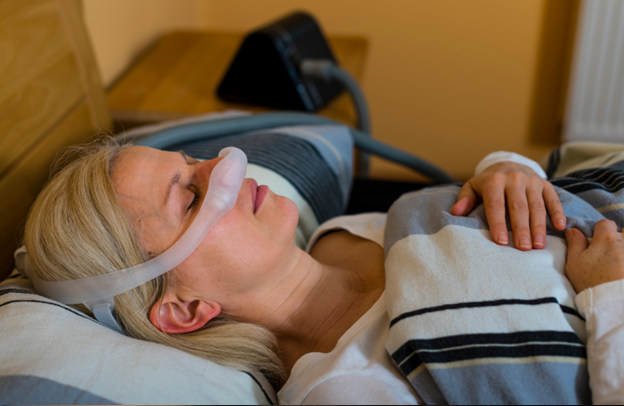Obstructive Sleep Apnoea: Causes, Symptoms and Treatments

In the world of sleep disorders, few conditions pose as significant a threat to overall well-being as obstructive sleep apnoea (OSA). This silent disruptor of restful sleep is estimated to affect 5% of Australians and is a common but often overlooked sleep disorder.
This article aims to break down the basics of OSA – what causes it, who it affects, the symptoms, and available treatments. If you think you may be suffering from obstructive sleep apnoea but aren’t sure, continue reading to see if the symptoms listed match yours.
Causes of OSA: Who Does It Affect?
Obstructive sleep apnoea is one of the two types of sleep apnoeas and is considered a serious medical condition. But what exactly is obstructive sleep apnoea?
This type of sleep apnoea occurs when the muscles in the back of your throat relax, narrowing your airways, which can reduce the level of oxygen in your blood. When this happens, your brain senses that you can’t breathe and briefly wakes you so you can reopen your airway.
As a way for your brain to wake you up, you may choke, gasp or snort, and the pattern can repeat itself five to 30 times an hour. This makes it hard to reach the deep, restful phases of sleep you need to be able to wake up refreshed and ready for the day.
So, what are some of the causes of obstructive sleep apnoea, and who does it affect?
- Obesity
- Increasing age
- Any gender
- Family history
- Anatomy
- Alcohol or sedative use
- Smoking
- Hypertension
- Breathing disorders, such as asthma
- Menopause
- Anatomic abnormalities of the upper airway
It’s important to understand that the idea that only “old, fat males” get OSA is no longer accurate. Studies have found young, fit and healthy females in their 20s diagnosed with OSA due to genetics and anatomical variations.
Signs of Obstructive Sleep Apnoea

Do you think you may be suffering from obstructive sleep apnoea but aren’t sure? Below are the most common signs of OSA.
Clinical Signs and Symptoms
- Intermittent snoring
- Excessive daytime sleepiness
- Waking up from gasping or choking
- Non-refreshing fragmented sleep
- Poor memory
- Irritability and personality changes
- Morning headaches
- Gastroesophageal reflux disorder (GERD)
Cardiovascular Symptoms
- Systemic hypertension
- Cardiac arrhythmias
- Cerebrovascular disease
- Pulmonary hypertension
Treatment of Obstructive Sleep Apnoea
Dentists can check for signs of OSA through routine check-ups. If they believe you may have it, they will refer you to a specialist who can diagnose you. Once you’ve been diagnosed with obstructive sleep apnoea, there are a range of treatment options available.
Conservative Treatments
While the treatments below won’t cure obstructive sleep apnoea, they can reduce it to the point where it stops or isn’t severe enough to cause symptoms.
- Weight loss: If you are overweight, losing weight is a recommended way to reduce your snoring and OSA.
- Reduce alcohol consumption: Alcohol worsens snoring and OSA due to the throat muscles relaxing. If you’ve noticed that drinking alcohol makes your OSA worse, drinking less or no alcohol may be an effective form of treatment.
- Change sleeping position: Sleeping on your back is a sure sign that snoring will occur and, therefore, OSA. You can invest in special support pillows to prevent you from sleeping on your back.
- Manage your blocked nose: A blocked nose causes mouth breathing, leading to snoring and OSA. You could have a blocked nose for several reasons; however, nasal sprays are a great way to relieve congestion and get you breathing through your nose while you sleep.
Positive Airway Pressure (PAP)
Using a specialised device to increase the air pressure inside your airway while inhaling, positive airway pressure is considered the most effective way to treat OSA. The device pushes air through a hose that attaches to a special mask that you wear on your face while you sleep. The most common PAP device is the Continuous Positive Airway Pressure (CPAP) machine.
Oral Devices
OSA happens when the soft tissue in your head or neck, specifically around your mouth and jaw, press downward on your windpipe. However, you can wear special oral devices when you sleep that push your lower jaw forward, reducing the risk of snoring and obstruction.
Nerve Stimulators
The hypoglossal nerve controls the movements of your tongue, and one of the ways to get your tongue to move forward when sleeping is a nerve stimulator.
So, how does this work? An electrode is attached to the nerve under your jaw, which is connected to a device that has been implanted in the skin under your chest. While the electrical current is strong enough to prevent your tongue from relaxing too much, it’s mild enough so that it’s not uncomfortable for you.
You can turn the stimulator on before you sleep and off when you wake up.
Surgery
A range of surgeries are available to prevent blockages of your nose, throat and windpipe.
Some of the surgeries include:
- Somnoplasty: Reduces the soft tissue around the upper parts of your windpipe.
- Tonsillectomy/adenoidectomy: Removes your tonsils and adenoids, widening the opening where the throat, nasal and mouth passages connect.
- Uvulopalatopharyngoplasty: Removes your uvula, which is the tear-drop-shaped soft tissue that hangs at the back of your throat.
- Jaw: Different types of jaw surgery procedures can subtly change the position of your jaw so soft tissue can’t be easily pressed back into your airway.
- Septoplasty (nasal): This procedure straightens the soft tissue in your nose. By doing this, it makes it easier for air to pass through your nose and nasal passages.
Benefits of OSA Treatment

Positive airway pressure is the most common form of obstructive sleep apnoea treatment in Australia, so what are its benefits?
- Less snoring
- More energy
- Better moods
- A clearer mind
- Lower blood pressure
- Reduction in heart arrhythmias
- Lower stroke risk
Book An Appointment at Admire Dentistry
Do you wake up in the morning not feeling refreshed? That could be a sign that you have obstructive sleep apnoea.
Did you know dentists play an important role in identifying patients with OSA? During dental check-ups, dentists can recognise a small upper airway and other anatomic risk factors for OSA. If they suspect you may have OSA, they will refer you to a specialist who can run some tests and diagnose you.
Book an appointment at Admire Dentistry today for a general check-up to see if you show signs of OSA in your mouth and throat.




